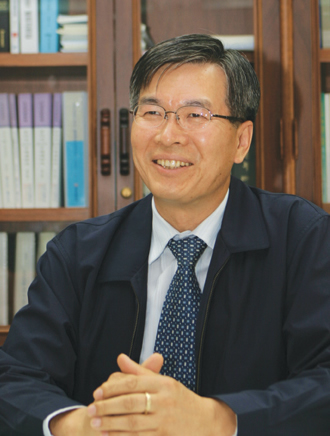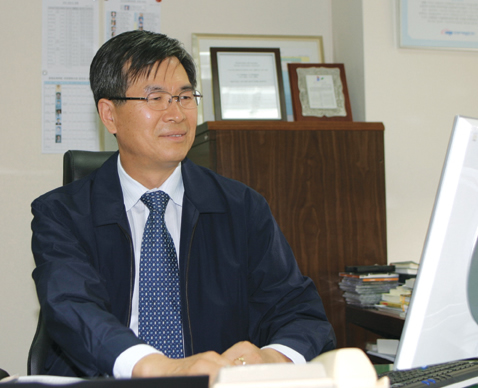WP Puts More Power into Developing New, Renewable Energy
Strives to raise revenue portion of new, renewable energy and overseas business sectors to 20 percent
 Western Power is focusing on exploring the new and renewable energy sectors, including the development of clean coal technology.
Western Power is focusing on exploring the new and renewable energy sectors, including the development of clean coal technology.
The following are excerpts of an interview between Cho Woo-chang, executive vice president of the Business Division at Korea Western Power Co. (WP), and NewsWorld.
Question: Will you tell our readers about the present status of the power plants your company operates and its future plans?
Answer: WP operates five power complexes nationwide -- Taean Thermal Power Complex, Pyeongtaek Thermal Power Complex, Seoincheon Combined Cycle Complex, Samryangjin Pumped Storage Power Division and Cheongsong Pumped Storage Power Division -- with a combined capacity of 8,885.3MW, accounting for 12.6 percent of Korea's total power generating capacity.
By load, facilities for base load take up a 45 percent power generation share: 16 percent for intermediate load and 39 percent for peak load. By fuel, coal-fired plants account for 45 percent of power capacity; petroleum-powered units, 16 percent; liquefied natural gas-powered ones, 26 percent; and pumped storage power plants, 13 percent.
WP has better power marketing than other power companies since more than 86 percent of its power production is provided to the Seoul metropolitan area, which has a 40 percent portion of Korea's total power demand. It is striving to realize the goal of maximizing its operational efficiency. To this end, WP seeks to build up an Energy Management System (EMS), make units defect-free and save costs and improve capacity factor by revamping operation and maintenance processes.
Q: Will you tell us about the current status of units under construction and future construction plans?
A: WP is now constructing the Gunsan Combined Cycle Unit 1 with a capacity of 718MW. The project, which was 57.25 percent complete as of September, is scheduled to be dedicated in May 2010. We're now working on a project to build the Taean Integrated Gasification Combined Cycle (IGCC) plant with a capacity of 300MW by October 2012. The highly-efficient and environmentally-friendly IGCC plant embraces an advanced technology that turns coal into gas, or synthesis gas (syngas). WP is currently engaged in three construction projects: the Garolim tidal power plant with a capacity of 520MW by December 2012, the Godeok combined cycle plant with a capacity of 700MW by June 2011 and the Yangju combined cycle plant with a 1,400MW capacity by December 2013. WP will be responsible for the operation and maintenance of the three plants after their completion.
WP submitted to authorities applications to build the Gunsan combined cycle unit 2 with a capacity of 700MW by 2014 and the Taean thermal power units 9&10 (1,000MWx2) by 2017 in accordance with the government's Fourth Power Supply Master Plan. The feasibility study on the construction of the ultra super critical (USC) Taean units has been already completed.
WP looks to the exploration of the community energy system (CES) business as its new growth engine.
Prospects for a CES business project that WP is undertaking together with Lotte E&C, Incheon City Gas and Kenertec are upbeat. The project to supply waste heat of 923 Gcal/h from the Seoincheon Thermal Power Plant to the Cheongna District in the Incheon and Gimpo areas from 2012 is designed not only to have synergetic effects by capitalizing on the existing facilities, but to conserve energy by supplying heat to residents. It is planning to bid on a CES project for Geomdan, being developed as a new satellite city of Incheon.
Q: Will you elaborate on the status of new and renewable energy development projects being carried out by WP and its future plans?
A: WP has signed a Renewable Portfolio Agreement (RPA) with the Ministry of Knowledge Economy (MKE) to follow up on the national energy policies and proactively cope with pacts on climate change. The new and renewable energy investment pact calls for earmarking 178 billion won for the development of new and renewable energy facilities with a combined capacity of 118.2MW during the period between 2006 and 2008.
We operate the Taean photovoltaic, the Taean micro-hydroelectric and the Samryangjin photovoltaic plants with a combined capacity of 5.3MW.
WP is now focusing on new and renewable energy projects, including the Garolim tidal power, the Taean IGCC and fuel cell projects.
The Garolim tidal power project calls for meeting 30.3 percent of 1,715MW as the total renewable energy target in Korea. The planned tidal power unit is designed to generate 950GWh of electricity yearly, thus resulting in substituting 1.55 million barrels of crude oil per annum and cutting 590,000 tons of greenhouse gas emissions yearly.
The Taean IGCC project, being jointly undertaken by WP, KEPCO and other companies, is part of its clean coal technology campaign, a technology designed to reduce the environmental impact of coal. There is an estimated 300 years worth of coal reserves, compared to 40 years for crude oil and 100 years for natural gas. Clean coal technologies now under development are involved in city gas, petroleum, combined cycle power and hydrogen. The projected Taean IGCC power unit, which is adopting coal gasification technology, is to be test-operated by 2014.
WP is participating in a national joint 250kW-class fuel cell project. It plans to complete a wind power plant with a capacity of 2.4MW by December 2010.
Q: What steps is your company taking to cope with climate change, including building up a greenhouse gas inventory management system?
A: The domestic power generation industry accounts for about 25 percent of the nation's total greenhouse gas emissions. Since the early 1990s when the world began global debates on climate change, the industry has gone to great pains to establish a power supply plan and develop technologies to reduce greenhouse gasses.
In 2005, the power industry inaugurated a task force to work out measures to cope with climate change and build a foundation for the establishment of countermeasures. The industry has been preparing for the establishment of a statistical system for the management of greenhouse gasses and the introduction of carbon emission trading, while joining global technology collaboration efforts through the Asia-Pacific Partnership on Clean Development and Climate (APP).
WP is putting its heart and soul into preparing for the post-Kyoto climate change pact era by establishing such countermeasures as the improvement of energy efficiency, expansion of new and renewable energy sources and the creation of "carbon" businesses.
We're no longer reacting to climate change. We have to be proactive in the development of new and renewable energy technologies including carbon capture & storage (CCS), which is an approach to mitigate global warming based on capturing carbon dioxide from fossil fuel power plants. If we neglect a low-carbon, green growth strategy, we may be overwhelmed by foreign technologies and face more stringent trade barriers.
Q: What're your strategies to explore foreign markets?
A: WP is striving to proactively explore foreign markets in order to overcome difficulties in the saturated domestic market and create future growth engines.
We're putting more energy into making the most of the expertise WP has acquired in the operation and maintenance of power plants.
WP has been adopting such strategies as participating in projects initiated by KEPCO in stepping up collaboration among domestic power companies and forming diverse portfolios of thermal, combined cycle, hydroelectric, combustion and wind power in consideration of power development conditions of each foreign market.
We're implementing a program to select and train manpower reserves for the exploration of foreign markets in order to foster experts with an international business insight.
WP is participating in three power projects ranging from construction to operation in the Philippines, Indonesia and Laos and a thermal power unit maintenance project in Nigeria.
Q: What's WP's mid- and long-term strategy and vision?
A: WP has its corporate tenets -- the world's 3E (energy, environment, expertise) power company. It seeks to realize a bright, affluent society by supplying clean energy under the catchphrase, "the cleaner, the brighter." WP aims to post 5 trillion won in sales and raise its power generating capacity to 17,000MW; to increase the portion of revenues in new and renewable energy sources and overseas business fields to 20 percent; to upgrade management quality to Six Sigma management levels; and to become a top 10 admired company in Korea.
To this end, we are striving to secure a competitive edge in the power-generating sector by creating future growth engines, stepping up global competitiveness and fulfilling social responsibility.
Corporate leaders need to motivate junior officials to work hard and participate by listening more to them and having open communication channels. CEOs who have made their own fortunes tend to have top-down discussions with their men, unilaterally speaking, not listening. In this regard, I've completed a CEO coaching course from the Seoul School of Integrated Sciences & Technologies. nw
Cho Woo-chang, executive vice president of the Business Division at Korea Western Power Co. (WP).
WP Executive Vice President Cho Woo-chang explains WP's plan to explore the new and renewable energy sectors during an interview with NewsWorld.
3Fl, 292-47, Shindang 6-dong, Chung-gu, Seoul, Korea 100-456
Tel : 82-2-2235-6114 / Fax : 82-2-2235-0799